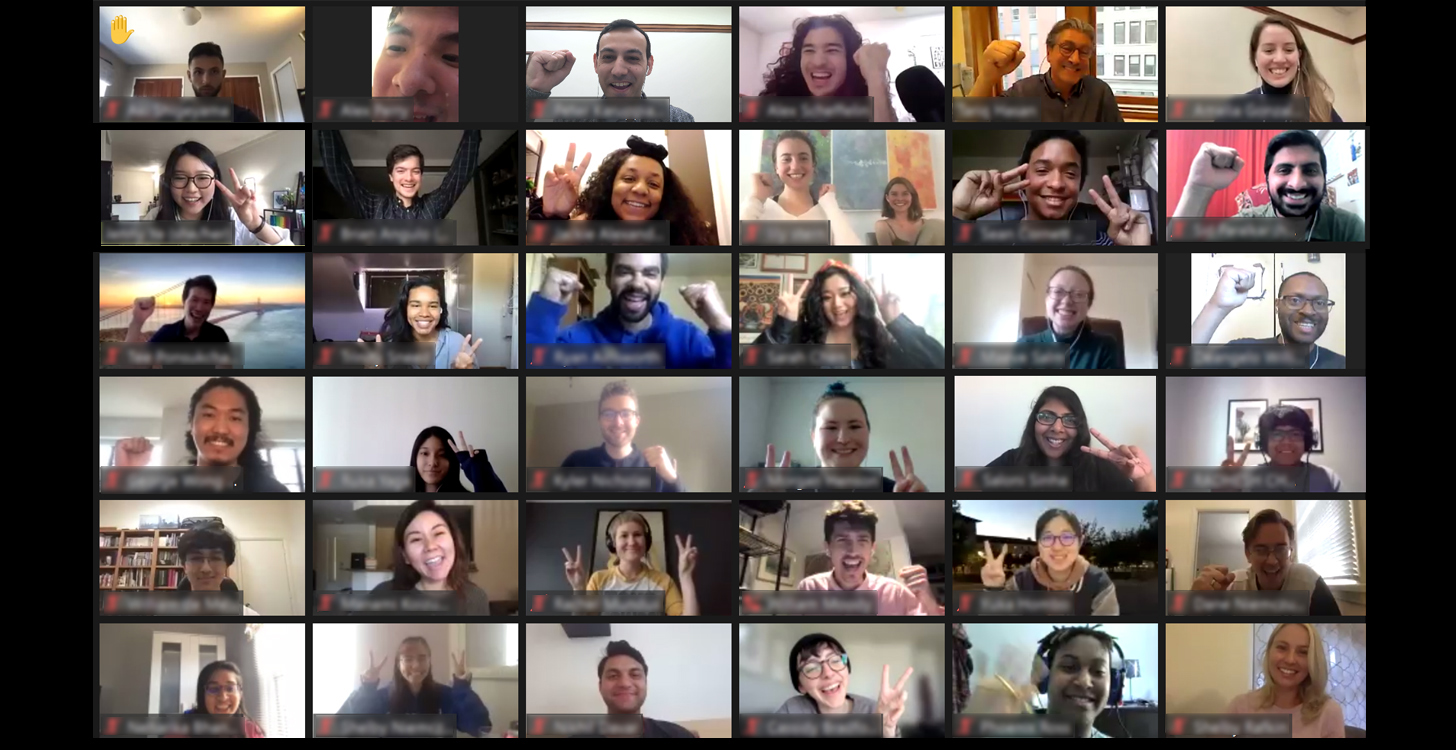Tariq Hasan was a Ph.D. student and chapter young men’s leader when he faced dissertation writer’s block in the midst of living hand to mouth with his wife and two small children.
He was about to quit school, in fact, when he recalled the determination he’d made to the 40 young men in his chapter: to finish his program and show actual proof of his Buddhist practice.
“I thought, ‘Yes, they’ll understand [if I quit], but they’ll never believe in the possibility of their dreams again,’” Mr. Hasan recalled. “So, I prayed to the Gohonzon that I would rather collapse from all-out exertion than not finish my doctorate. It was this determination for the sake of those young men that eventually led to my completing my studies.”
Mr. Hasan, the SGI-USA senior vice general director, spoke on April 17, 2021, at the SGI-USA student division virtual lecture themed “How Do We Make Our Dreams a Reality in These Uncertain Times?” joined by some 400 student division members and guests, including high school seniors. Mr. Hasan touched on key points from Ikeda Sensei’s lecture from the series “The Buddhism of the Sun— Illuminating the World” titled “Happiness for Oneself and Others—Transforming Our Life State Through Sharing Buddhism.”[1]
The virtual meeting served as a fresh departure for the SGI-USA student division, which recently narrowed its focus to supporting youth ages 18–25 who are enrolled in a post-secondary education program or school. Previously, the age limit was 35. Such changes are part of the youth division’s larger vision to develop a new generation of leadership toward 2030, the Soka Gakkai’s centennial.
To these future leaders, Mr. Hasan emphasized the importance of developing a “spiritual core,” enabling us to win over ourselves, transform our lives and our society in the process.
The Key to Victory Is to First Win Over Yourself
The key to winning in any endeavor is to first win over oneself. How we perceive our obstacles depends on our inner life state. … When we triumph over our own limitations, we will make great strides in our lives and shine with the brilliant light of victory.[2]—Sensei
Why has the Soka Gakkai grown to 12 million members in 192 countries and territories? It’s because the practice of Soka Gakkai Nichiren Buddhism has enabled 12 million people to develop their spiritual core, also known as their life state.
“How does one develop one’s spiritual core?” Mr. Hasan asked the audience. “It’s through the practice of Nichiren Buddhism, which entails faith, practice for oneself and others and study.”
Sensei aptly describes the essence of developing a spiritual core as winning over oneself. This has enabled members not only to clearly see actual proof in their own lives, Mr. Hasan said, but also to see a clear path toward helping others and solving societal issues. He then outlined four qualities that make up our “spiritual core.” They are:
1. The Bodhisattva Practice Is the Essence of Nichiren Buddhism
One’s own happiness to the exclusion of others is not true happiness. We cannot be happy while others are suffering. Seeking happiness for oneself and others is genuine happiness.[3]—Sensei
The first key to developing our “spiritual core” is what Buddhism calls “bodhisattva” practice.
Mr. Hasan explained the traditional view of bodhisattvas as those who delayed their enlightenment to work for others’ happiness. Whereas Nichiren Buddhism defines it as a state in which we strive for our own enlightenment through helping others simultaneously.
This is not a uniquely Buddhist idea, he noted. “Many studies in society have shown that people who work for others’ happiness are the most fulfilled and happy people in the world,” Mr. Hasan said. “Therefore, those of us who practice Buddhism understand the importance of carrying out the bodhisattva practice as the path to our own victory.”
2. Live With a Sense of Mission
The Japanese word for mission means “to use one’s life.” For what purpose do we use our lives? … Youth is a time when we ponder the meaning of our existence. … If you continue to challenge yourselves [through chanting] without giving up, you will come to see the mission that is yours and yours alone to accomplish.[4]—Sensei
Sensei has mentioned that each one of us has a mission—a mission we alone were born to fulfill. Our absolute happiness depends on whether we can accomplish this mission based on our Buddhist practice.
Chanting Nam-myoho-renge-kyo, he said, is what takes us on an incredible journey as we try to achieve our dreams or solve the problems that we are facing. “In the process, we end up finding a greater mission than we ever thought we possessed, a greater life than we could even dream of and live out a life without any regrets.”
3. Don’t Give Up on Yourself
The only real mistake you can make when you are young is giving up on yourself or allowing fear or failure to prevent you from trying to accomplish something.[5]—Sensei
The third quality for developing our inner core is to not give up on yourself.
Mr. Hasan said that this is quite different from the way people generally live—starting out with great dreams but compromising when things don’t work out.
“I practice Buddhism because I don’t want a mundane life,” he said. “I don’t want to live an average, humdrum life. From my own experience of many years of practice, I can tell you your life will become greater than what you can imagine.”
4. Never Forget Who You Are
Don’t allow your immediate situation to make you lose hope or panic. Though you may do something you regret, have problems or make mistakes, the future is long. Don’t be a faint-hearted person who frets or despairs over every little thing. …
You must love, respect and treasure yourself. You’ll be miserable if you allow yourself to be swayed by the prejudices, passing trends, and contradictions of into it. society. Never forget to be who you are, to be true to yourself.[6]—Sensei
Mr. Hasan stressed two points here: 1) You must love, respect and treasure yourself; and 2) Never forget to be who you are, to be true to yourself.
Explaining that these four qualities cannot just be willed into our lives, Mr. Hasan presented three practical ways or “keys to victory” for developing them through our Buddhist practice: 1) make a determination; 2) have a shared commitment with the mentor to ensure the happiness of everyone; and 3) prayer and action rooted in the bodhisattva practice of sharing Buddhism widely.
Introducing others to Buddhism is the greatest action we can take for our own happiness and victory, Mr. Hasan emphasized. “This is the eternal practice of Soka Gakkai Nichiren Buddhism.”
—Prepared by the World Tribune staff
Voices from the Students
 Brandon Poythress
Brandon Poythress
Southern Methodist University
The biggest highlight for me was the guest leader’s experience of challenging himself in SGI activities while doing a Ph.D. program. He said there wasn’t a lot of youth division pursuing higher education at that time, but he wanted to show actual proof. I have always struggled with winning in daily life and also fighting hard in my SGI activities. I learned that the true way of Buddhist practice is to challenge both.
 Trinity Sneed
Trinity Sneed
Glendale Community College
The guest leader talked about how effort and hard work connect our dreams to reality. That resonated with me because oftentimes I find myself stuck contemplating these big dreams that I have for myself rather than taking the necessary actions to actualize them. Whether or not I make my dreams happen is a matter of me making the effort and putting my entire life into it.
 Jordan Stallworth
Jordan Stallworth
Princeton University
As a senior who is thinking about what to do post-graduation, I have some uncertainty about my future. Chanting Nam-myoho-renge-kyo and maintaining hope were the big takeaways for me. I don’t have the Gohonzon yet, but I am going to continue chanting earnestly for the answers within. That way, I’ll know what actions to take next.
The Mission of Student Division
On June 30, 1957, some 500 youth assembled with second Soka Gakkai President Josei Toda for the founding of the student division. It would be the final group consecrated under his leadership before his passing 10 months later.
President Toda had seen in the student division members the great mission to realize the ideals of Buddhist humanism in society as leading figures in their fields—business, politics, academia and various other key positions both in the secular arena and within the Soka Gakkai.
You are reading {{ meterCount }} of {{ meterMax }} free premium articles

